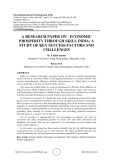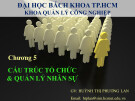
http://www.iaeme.com/IJM/index.asp 1 editor@iaeme.com
International Journal of Management (IJM)
Volume 8, Issue 3, May–June 2017, pp.01–13, Article ID: IJM_08_03_001
Available online at
http://www.iaeme.com/ijm/issues.asp?JType=IJM&VType=8&IType=3
Journal Impact Factor (2016): 8.1920 (Calculated by GISI) www.jifactor.com
ISSN Print: 0976-6502 and ISSN Online: 0976-6510
© IAEME Publication
A RESEARCH PAPER ON - ECONOMIC
PROSPERITY THROUGH SKILL INDIA: A
STUDY OF KEY SUCCESS FACTORS AND
CHALLENGES
Dr. Yathish Kumar
Mangalore University College Hampankatta, Mangalore, India
Ramya K R
Mangalore University Evening College Hampankatta, Mangalore, India
ABSTRACT
India is a country with major represent youths. As far the economic development
of our country is concerned, India is still lagging behind due to various problems like
poverty, unemployment, illiteracy, medical infrastructure etc. Youth plays a crucial
role in achieving economic prosperity of the country.
The main aim of Skill India is a concept introduced by Hon’ble Prime Minister of
India Narendra Modi in March 2015 is to create opportunities, space and scope for
self-development of the talents of Indian Youth. This program is initiated in to provide
training and skill development covering youth of each and every village.
In the present scenario, it is found that most of the youth being educated are been
facing severe unemployment problem due to lack of skills and technical knowledge.
Most of them are unaware of the developments taking place in the modern technology.
Attempts are made through skill development programme to provide creative technical
skill training to youth population to encourage the concept of self entrepreneurship by
providing them training in various activities and providing financial assistance
through loans at a cheaper rate of interest.
Lot of activities is implemented by the government to enhance the level of
creativity and infuse leadership qualities in youth. But still some deviations and
loopholes are found. Now the new approach is to concentrate on job creation and
youth without idleness.
In this paper, an attempt has been made to identify how far the skill development
programmes have achieved success and what are the major problems faced by the
youth in initiating the skill development programmes launched by government.
Key words: Creative Skills, Economic development, Job Creation, Self development,
Talent Acquisition





















